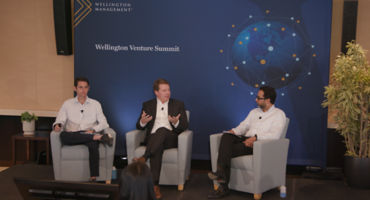- Deal Lead, Wellington Access Ventures
Skip to main content
- Funds
- Insights
- Capabilities
- About Us
- My Account
United States, Institutional
Changechevron_rightThank you for your registration
You will shortly receive an email with your unique link to our preference center.
The views expressed are those of the author at the time of writing. Other teams may hold different views and make different investment decisions. The value of your investment may become worth more or less than at the time of original investment. While any third-party data used is considered reliable, its accuracy is not guaranteed. For professional, institutional, or accredited investors only.
Since the earliest days of commerce, financial and technological innovations have continually changed the ways in which goods and services are exchanged. As Figure 1 shows, in recent decades, platforms that enable such methods as online shopping, mobile pay, peer-to-peer payment, buy-now-pay-later, among others, have fundamentally altered relationships between buyers, sellers, and products. In our view, the next tectonic shift is already underway: AI and machine learning will transform consumerism, leading to unprecedented degrees of personalization in many industries.
To achieve hyper-personalization, the next wave of AI will likely push the consumption ecosystem beyond its current state. AI tools should be able to leverage the oceans of data that already capture a customer’s browser history, “dwell time” on specific products, and digital footprints on social media, to infer that same person’s emotions, opinions, viewing environment, and even their metabolic data. Rather than corralling consumers toward “similar items,” the software will likely match offerings with the specific contours of a customer’s personal identity. Historically, retailers simply leveraged a consumer’s online data to deliver targeted ads. While this should remain true, the power will return to consumers, as the search for specific products and services becomes more tailored to their preferences.
AI can enable visual search and interpretive computer-vision capabilities that simplify and personalize the consumer experience to a degree previously unimaginable. Through machine learning and predictive analytics, AI-powered software can help shoppers identify products quicker and deliver customized suggestions for substitutes at similar (or varying) price points. Computer vision will likely process a consumer’s 3D visual information and rapidly analyze this data, deriving insights on a customer’s mood and feelings about the item, in addition to its fit. This level of accuracy can allow brands to deliver content, products, and services to consumers while supplying precise inventory management details for retailers.
A search for, say, a “red cashmere sweater under US$100” may leverage algorithms that recommend brands and sizes that perfectly fit the customer’s body while also filtering through their social media preferences to show that their trusted network of influencers, friends, and experts also use or recommend the product. Collectively, this information can provide powerful validation and reassurance in the purchase decision.
In addition to helping consumers identify and purchase existing products that are perfect for them, AI will be able to facilitate mass markets for bespoke products produced at scale. In particular, the health, wellness, and beauty categories are candidates to amplify this approach. Consumers’ quest for longevity presents a gaping hole and a tremendous opportunity for companies to tap the science behind longevity. Customers — not least of which include 77 million US baby boomers — want to live longer, looking and feeling their best as they age. AI will help companies deliver targeted, personalized solutions to concerns like hair loss, wrinkles, and hyperpigmentation, for instance, and make those solutions more affordable and accessible to consumers.
AI has given formulators the ability to test and iterate formulations quickly, yielding more effective products that deliver enhanced results on a molecular level. These new formulas can help companies overcome customer-related “pain points,” where solutions to date have been adequate, but not necessarily transformative. Thanks to AI, consumers should be able to order vitamins that contain the precise levels of nutrients their specific body needs. Using personal metabolic data, supplement companies will be able to fulfill orders that optimize levels of various vitamins and minerals specific to a customer’s physiology. Generic, one-size-fits-all vitamins and supplements may eventually be a thing of the past. This same model can be applied to cosmetics, hair care, and a range of personal wellness and beauty products.
Finally, brick-and-mortar stores, the supposed dinosaurs in the age of digital commerce, will once again shine thanks to AI and augmented reality. AI may be able to help stores morph from being transactional hubs to offering immersive experiences. They can become experiential playgrounds, delivering shopping experiences so multidimensional, so emotionally resonant, that making a purchase will become a memorable, sensory journey. Retailers should be able to connect with consumers on a deeper level. Customers can shop while listening to personalized playlists. They can see customized digital art exhibits or attend personally crafted culinary tastings. The technology will be able to suggest alternatives to help a customer create an outfit they love in real time.
The in-store renaissance may also be a function of a shift in recent consumer behavior. Research has begun to reveal consumers’ weariness of certain aspects of e-commerce, leading to a phenomenon known as “the great unsubscribe.” Shoppers, tired of the barrage of inbound, impersonal promotions via email or on social media, are hungry for experiences. While this trend has been forming for many years, the advent of AI has accelerated the potential for retail stores to become destinations worthy of a trip off the couch.
Companies that understand the power of AI in commerce and embrace the shift toward hyper-personalization will be able to explore software that:
Expert

Venture capital outlook for 2026: 5 key trends
Continue readingMultiple authors
Human capital management for private companies
Continue readingMultiple authors
Venture and growth equity: The future of private-market evergreen funds?
Continue readingCollaboration in practice: Late-stage growth
Continue readingCollaboration in practice: Late-stage biotech
Continue readingCollaboration in practice: Climate venture capital
Continue readingCollaboration in practice: Early-stage venture
Continue readingURL References
Related Insights
Stay up to date with the latest market insights and our point of view.
Thank you for your registration
You will shortly receive an email with your unique link to our preference center

Venture capital outlook for 2026: 5 key trends
We explore 2026's venture capital trends, highlighting IPO momentum, M&A acceleration, secondary market growth, public-private convergence, and the focus on quality investments.
Multiple authors

Human capital management for private companies
We discuss why effective people management is critical for private companies and outline four strategic focus areas that can help companies navigate evolving employee needs, regulatory changes, and investor expectations.
Multiple authors

Venture and growth equity: The future of private-market evergreen funds?
Investment Director Cara Hubbard highlights how the VC and growth equity landscapes are transforming, details the rising popularity of evergreen funds, and shares how these themes may converge to expand access to private markets.

Collaboration in practice: Late-stage growth
Matt Witheiler, Head of Late-stage Growth, explores the impact of Wellington’s collaborative culture. He highlights the potential benefits of working with his private-market colleagues across sectors and stages as well as leveraging Wellington’s hundreds of public-market experts.

Collaboration in practice: Late-stage biotech
Nilesh Kumar, Head of Biotech Private Investing, explores how working with Wellington’s public-market biotech experts helps his team better understand the feasibility of emerging biotech innovations.

Collaboration in practice: Climate venture capital
Greg Wasserman, Head of Private Climate Investing, highlights the importance of collaborating with Wellington’s later-stage private market investors and public market experts to better understand best practices, valuation, exit opportunities, and more.

Collaboration in practice: Early-stage venture
Jackson Cummings, head of Wellington Access Ventures, outlines how collaborating with our later-stage private teams, public market industry analysts, and Value Creation Team can benefit his early-stage venture team.

Wellington Venture Summit
The Wellington Venture Summit brings our portfolio companies the breadth of our investment expertise and networks under one roof. Watch highlights from the summit on preparing to go public, fundraising your next round, and much more.

The transformative power of vertical AI agents
Olivia Hurley and Rie Kimoto explore Japan's banking sector, highlighting regional banks' undervaluation and M&A opportunities driven by regulatory changes and demographic shifts.

IPOs aren’t dead, they’re just napping
Experts from our venture capital and trading teams explore the current IPO landscape. They highlight three challenges and three opportunities for private companies aiming to go public today.
Multiple authors

Building the future: Advances in AI infrastructure for autonomous agents
Van Jones highlights AI infrastructure advancements, emphasizing emerging protocols and data solutions for autonomous agents driving innovation and connectivity.
By
URL References
Related Insights
© Copyright 2025 Wellington Management Company LLP. All rights reserved. WELLINGTON MANAGEMENT ® is a registered service mark of Wellington Group Holdings LLP. For institutional or professional investors only.
Enjoying this content?
Get similar insights delivered straight to your inbox. Simply choose what you’re interested in and we’ll bring you our best research and market perspectives.
Thank you for joining our email preference center.
You’ll soon receive an email with a link to access and update your preferences.